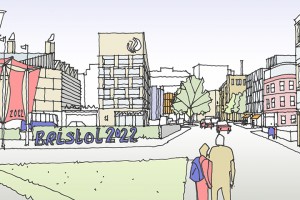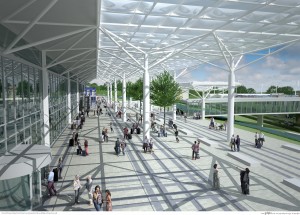Bristol is to make its biggest show of strength ever to the international property development market next week by promoting schemes worth more than £40bn.
The city’s Temple Quarter Enterprise Zone, YTL Development’s Brabazon scheme at Filton Airfield – a possible site for a long-awaited arena – and Bristol Airport’s ambitious multi-million expansion, which could create 1,000 jobs over the next decade, are among the schemes to be showcased at MIPIM, the world’s largest property investment gathering. 
A delegation of more than 20 of the region’s major businesses and public sector partners, led by inward investment agency Invest Bristol and Bath, will attend the annual event in Cannes between Tuesday to Friday. Mayor of Bristol Marvin Rees and West of England Metro Mayor Tim Bowles will also attend.
It is the biggest delegation sent from the West of England, with the private sector playing a bigger role than ever.
The Bristol and Bath exhibition stand will host its largest programme of panel discussions and roundtable events to explore key themes including accelerating housing delivery, unlocking infrastructure and re-imagining city centres.
Among organisations taking part in the delegation are AHR, Arcadis, Arup, Atkins, Avison Young (formerly GVA), Bouygues, Bristol Airport, Bristol-based national law firm Burges Salmon, housing provider Curo, English Cities Fund, Hoare Lea, Muse Developments, property agents Savills, developer Skanska, architects Stride Treglown, University of Bristol, Willmott Dixon, Womble Bond Dickinson, YTL Developments, four local authorities Bath & North East Somerset Council, Bristol City Council, North Somerset Council and South Gloucestershire Council, and the West of England Combined Authority.
MIPIM is attended by around 25,000 delegates including potential investors, property agents, developers and media, from more than 100 countries. It is widely regarded as the prime shop window for major developments.
Metro Mayor Tim Bowles said the event gathering offered a unique opportunity to promote the city-region and showcase the opportunities for growth to an international audience of investors and developers.
“This is a key event for us to showcase our region, and the opportunities it offers, on the world stage,” he said.
“We have ambitious plans for inclusive growth across the West of England. As a prosperous region, we are home to a highly skilled workforce, a diverse cultural and heritage landscape and high growth sectors including technology, aerospace and the creative industries.
“To deliver the housing and infrastructure to support our continued prosperity, we want to work with innovative partners to deliver solutions that are right for our region and its residents.
“At MIPIM we will promote the region to investors and trade partners. Based on predicted growth, over the next 20 years, we estimate that we will need to invest over £10bn in infrastructure – private sector investment will be essential to deliver this.
“As well as promoting our region and investment opportunities, our Invest Bristol and Bath stand will also provide a platform for businesses from our region to promote themselves. We’ll be there competing against cities and regions from across the UK and across the world.”
Bristol’s Temple Quarter Enterprise Zone, pictured top, is regarded as one of the most successful of its kind, having attracted a range of businesses. It will also become home to the University of Bristol’s £300m Innovation Campus while insurance giant Legal & General last year revealed a new scheme for Temple Island – the derelict five-acre site owned by Bristol City Council formerly known as Arena Island – which would create a ‘vibrant new quarter of the city’.
The plans include a large capacity conference centre and exhibition space, a 345-room hotel – which would be the city’s largest – and 550 new homes, nearly half of them designated as affordable – and two major office buildings.
Bristol Airport’s development, pictured above, is to enable it to handle 12m passengers a year. The scheme, submitted to North Somerset Council planners in December, would generate an additional £1.4bn for the regional economy by the mid-2020s.
The planning application is the latest stepping stone in the airport’s long-term plan of being capable of handling up to 20m passengers a year by the mid-2040s.
Annual passenger traffic is likely to hit 9m this year. Under its current planning permission, the terminal is limited to 10m passengers a year – a figure it is likely to hit in the early 2020s.






























